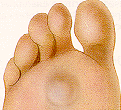Calluses
The formation of calluses is caused by an accumulation of dead skin cells that harden and thicken over an area of the foot. This callus formation is the body’s defense mechanism to protect the foot against excessive pressure and friction. Calluses are normally found on the ball-of-the-foot, the heel, and/or the inside of the big toe. |
|
Some calluses have a deep-seated core known as a nucleation. This particular type of callus can be especially painful to pressure. This condition is often referred to as Intractable Plantar Keratosis.
Calluses develop because of excessive pressure at a specific area of the foot. Some common causes of callus formation are high-heeled dress shoes, shoes that are too small, obesity, abnormalities in the gait cycle (walking motion), flat feet, high arched feet, bony prominences, and the loss of the fat pad on the bottom of the foot.
Causes
Calluses are a symptom of some underlying problem which exists in the ball of the foot. The normal foot can carry our weight comfortably, without the formation of calluses and pain. When a callus occurs, it signifies a change is occurring in our metatarsals (the long bones of our feet to which our toes connect). We have five metatarsals, and they each carry a portion of our body weight as we walk. When one or more metatarsals carry more weight then they are supposed to, the skin under these bones becomes thick, hard, and painful.
Treatment
To provide relief from callus pain, the abnormal weight the callused area is carrying must be reduced and re-directed to the rest of the foot. The affected area where the callus is present must be accommodated for. This can often be accomplished by transferring weight from the affected area to another portion of the foot. Podiatrists agree that the easiest and most cost effective way to accomplish this goal is with the use of Custom-Made Orthotics. These are comfortable, long lasting, medical devices which are made from molds of your feet, and they will alleviate callus pain by doing the following:
-
Remove excessive pressure from the bones and joints in the balls of the feet, where the painful callus is located. The orthotic will then re-distribute this pressure, or weight, to the rest of the ball, and back into the arch.
-
Adjusting and accommodating for any abnormal walking patterns you have, such as pronation (a twisting of the foot outward, so that as you walk you apply more weight on the inner border of your foot). Pronation, and other biomechanical defects such as intoeing, outtoeing, high arches, etc… affect the way weight is distributed across the balls of our feet when we walk. Our Custom-Made Orthotics will allow the feet to function in a normal position when they strike the ground, rather than in a twisted position, thus removing the excessive weight and pressure from painful calluses.
-
Protecting the balls of the feet with materials that will absorb friction and excessive pressure, rather then passing them to the balls of the feet. The materials we use act as though more fat and padding were added to the balls, without adding excessive bulk.
For long lasting relief of callus pain, arch supports will usually give you relief. They are made of medical grade, space age, long lasting materials (guaranteed to provide you with comfort for years). They are comfortable, and will fit in any shoe with a 1 1/2 inch heel or less. The same pair of orthotics can be used in your dress or athletic shoes (you will need only one pair to provide you with comfort in all of your activities). Click here for more information about our comfort giving Custom-Made Orthotics.
Pain Relievers:
-
Arch supports or Custom-Made Orthotics will protect your calluses comfortably, for years, allowing pain free walking, running, dancing, and all other weight-bearing activities.
-
PediNova III Electric Nail and Foot Care System safely removes dry, thick, and callused skin without sharp blades or chemicals. Professional grade instrument, crafted with incomparable German technology. Easy-To-Use, with everything you need to make skin and nails look and feel good.
-
Hands & Feet Pumice Sponge is the hygienic way to soften, exfoliate, and clean skin. The unique shape smoothes away hard skin on feet, heels, toes, hands, and elbows. Safely removes dry, thick, and callused skin without sharp blades or chemicals.
-
Callex Ointment is podiatrist-recommended. Thins and softens calluses and dry cracked skin. Made from natural plant enzymes and contains no acids or harsh chemicals.
-
Dr. Jill’s Moleskin Pads are thin, adhesive-backed material podiatrists use to pad and protect painful calluses.
-
Gel “U”-Shaped Callus Pads (Self-Stick & Re-Usable). The soft gel pad cushions the calluses and reduces ball of foot discomfort
-
Silipos Pure Gel Metatarsal Pads are soft gel cushions that help reduce pressure on the balls of the feet while providing maximum comfort. The anatomical design supports the ball of the foot.
-
Wear shoes with a low heel (about 3/4 to 1 inch high).
-
Wear shoes with thick, well padded innersoles and outer soles, such as walking shoes. Even bedroom slippers should be well padded.
-
Do not walk bare foot. Protect the bottoms of your feet with good shoes.
-
Use a pumice stone to regularly file down painful calluses. Do not cut or trim them. If you are a diabetic or have poor circulation, check with your family doctor before treating your calluses.
-
Do not use medicated pads on calluses. These pads contain acid, and frequently cause chemical burns which can lead to increased pain. If you want to apply pads to your feet to reduce the pain produced by calluses, use non-medicated pads. Remove these pads at the end of each day so that the skin does not breakdown.
